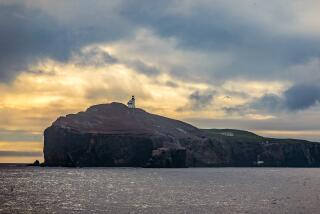Spying the Small Spectacles of New Brunswick
- Share via
As we waited by the ferry slip on Deer Island in New Brunswick, a talky woman from Florida turned to a local.
“Down home we call you all snowbirds ,” she said, “since you fly south for the winter. What do you call us?”
The seventh-generation Deer Islander hesitated for only a moment.
“We call you tor - ists ,” she said in the pleasant local lilt.
And tor - ists we were that wind-swept day as we debarked from the spanking-white ferry. Since leaving the mainland, we had seen bald eagles--on their nests and in flight--and listened to their urgent whistle.
We had passed myriad tufts of uninhabited islands whose bases seemed wrapped in rope. It turned out to be rockweed, or seaweed, piled up by receding tides, which here--in the Bay of Fundy--are the greatest in the world.
Deer Island is the smallest of the rugged Fundy Isles, only 7 1/2 miles long and no more than three miles wide. It is about as close to the coast of Maine as it is to New Brunswick.
In this finely etched maritime world, herring weirs stand offshore like flooded, fenced-in corrals. Crystalline fogs mound up over lighthouses and snake through forests of spruce.
This is a province where a seventh-generation native is impressive but not incredible. Throughout New Brunswick, casual reference is made to ancestors who came from Maine and New York in the l700s when the colonies declared independence from the Crown. Those who sided with Britain were called Loyalists. They settled this chunk of Canada.
The seventh-generation Deer Islander--the one quizzed by the Floridian--turned out to be Audrey Cline, a merry woman who teaches four subjects at the island school: geography, history, the novel and creative writing.
She and her husband, Ralph, a longtime fisherman and whale-watching expedition leader, also run the West Isles World bed and breakfast in their white-frame home at Lambert’s Cove.
As we sat around the dining table and nibbled on hickory-smoked salmon from local fish farms, I learned that Audrey’s ancestors were shipbuilders and that her hobby is photography. I learned that Deer Island claims to have the world’s largest lobster pound (at Northern Harbour) and the world’s second-largest whirlpool--called the Old Sow because of its snorting noise.
But the harbor pound was empty when I rode by, and the whirlpool was between whirls. I looked for smaller spectacles.
Deer Island is a place for bird-watching and whale-watching, for fishing, hiking and peace. It is an island without bridges; a year-round free ferry operates from Letete near St. George, a 20-minute ride. In summer, toll ferries run from Campobello Island and from Eastport, Me.
There are four small villages, four general stores, three nurses, one customs officer and four carpenters. There are a handful of bed-and-breakfast establishments, as well as a campground at Deer Island Point.
The cafe at the 45th Parallel Motel is billed as the only “sit down inside” restaurant. Take-away food stands cater to the day-trippers of summer. The 45th parallel--the latitude we had crossed on the ferry boat that morning--is halfway between the Equator and the North Pole. And that is about how it felt.
Because of abundant bird colonies, the richness of sea life and the clear, unpolluted waters, which attract scuba divers, part of the Deer Island archipelago has been proposed as Canada’s first Marine National Park.
Naturally, the islanders can’t decide if they want it.
“But we need jobs and income to be able to stay on the island,” Audrey Cline said as we drove through the village of Richardson. “The park would help. Fishing is not enough and there’s no more farming or shipbuilding. . . .”
We passed abandoned boatyards and the shell of a tall wooden building.
“When I was growing up, that was the leading store,” Audrey said. “Just looking at the empty buildings tells you those people are gone.”
But for a day-tripper, there are countless wonders: explosions of wild pear blossoms in spring, spying the rare right whales in July and August, hiking through birch woods in the fall, ice skating on frozen ponds in winter.
Most to be cherished, perhaps, is the chance to slow the clock--to be on an island that is ruled by tides, to photograph yesteryear gingerbread houses, to reminisce about old-time families and the way things were.
A woman from Toronto turned to Audrey toward the end of our island tour.
“When I was a child I came to Deer Island with my parents,” she said softly. “We stayed at a bed and breakfast somewhere near the water, and if you opened your window at night you could hear the whales sighing offshore . . . blowing as they passed so close to the island. Do you remember anything like that?”
“Oh yes,” said Audrey Cline. “That was Ralph’s aunt’s place. You could hear the whales sing.”
More to Read
Sign up for The Wild
We’ll help you find the best places to hike, bike and run, as well as the perfect silent spots for meditation and yoga.
You may occasionally receive promotional content from the Los Angeles Times.






